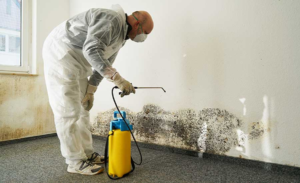Moisture is a termite attractant and can allow them to gain entry into your home. Checking for mud tubes, damaged wood, and discarded termite wings around the property can help spot infestations in progress.
Reduce moisture around foundations by ensuring the soil is properly graded and drainage is maintained (including gutters). Store firewood at least 20 feet away from structures. If you notice any of these issues, it is important to call Pest Control Prosper TX expert immediately.

Seal Leaks
Moisture is a major attractant for termites and other pests. Ensure that your home is properly ventilated and has adequate airflow, especially in basements and crawl spaces to avoid creating the ideal environment for infestations. Moisture can also be reduced by fixing leaky plumbing fixtures, using dehumidifiers in humid environments, and ensuring that all wood surfaces are well-sealed, especially around the foundation of your house.
Leaks in the exterior of your home and leaking gutters can create an environment that is conducive to termite infestations. To prevent this, ensure that your gutters and downspouts are in good working order and that they are directing water away from the foundation of your home. In addition, make sure that your sprinkler systems are properly aimed to minimize standing water near your home.
Keep wood products away from the ground to limit termite access. Termites often enter buildings through areas where wood is in direct contact with soil. This may include wood siding, door and window frames, stairs, and posts embedded in concrete and retaining walls. Eliminate these access points by removing cellulose mulch, replacing it with a non-cellulose alternative, and ensuring that wood siding is at least six inches above the ground level.
Maintain a regular inspection routine to identify the signs of a termite infestation, including mud tubes and hollow-sounding wood. Also, routinely check the foundation of your home for cracks and other damage.
Keep in mind that a professional can determine the best preventative treatments, such as a physical barrier, soil treatment, and baits or monitoring systems. Based on your home’s construction, climate, and other factors, a pest control expert can help you develop an effective termite prevention strategy. Contact a local termite specialist to schedule an appointment for a free estimate. A qualified termite extermination company will be able to provide you with an accurate, fast, and cost-effective solution to your termite problem. Termite infestations are a nightmare for every homeowner and should never be ignored. The longer a termite infestation goes on, the more damage it can do to your home.
Keep Your Home Clean
Termites love moisture and they are attracted to wood. Unfortunately, they also thrive in warm and dark places such as the inside of your home’s walls and floor framing. As a result, it can be difficult to detect a termite infestation until the wood is heavily damaged and it’s too late. Regular inspections can help to identify and stop an infestation in its tracks.
During your inspection, pay close attention to areas with high levels of moisture and areas where wood is in direct contact with the ground. These are ideal areas for termite colonies to begin and once an infestation begins, it can be very difficult to control.
One of the easiest ways to keep your house free from termites is to regularly remove food sources that attract them. For example, piles of firewood near your house can draw in termites as well as discarded tree stumps and limbs. Make sure to keep firewood stacked away from your house and at least 18 inches away from the foundation of your home, and ensure that all piles are properly anchored to the soil. You can also use a physical barrier to prevent termites from invading your property. Steel mesh and sands of specific sizes have been proven to work as effective barriers.
If you have a basement or crawl space that is poorly ventilated, consider investing in a dehumidifier to remove excess moisture. It’s also a good idea to install a dryer vent outside of your house so that it does not create moisture in the crawl spaces.
Regular inspections by a professional pest control expert can help to prevent a termite infestation before it has a chance to do damage to your home’s structural integrity. A pest control expert can inspect your home’s interior and exterior, checking for mud tubes, wood that sounds hollow when tapped on, and other signs of a termite infestation. Then, they can recommend the best preventative measures to take. These can include soil treatment, direct wood treatment, bait and monitoring systems, or other options that are based on the specific conditions surrounding your home.
Remove Wood Debris
Termites are attracted to moist wood that contains the cellulose they need to survive and grow. Moisture can cause cracks in wooden surfaces, which allows the entry of termites and other wood-destroying pests like carpenter ants.
Ideally, any wood around your home should be kept 20 feet or more away from the foundation of the house. This includes firewood piles (which should be far enough away to not attract snakes and other wild animals) and rotting tree stumps and dead branches.
It’s also important to keep your crawl space well-ventilated and to repair any leaky pipes, faucets, or vents. Proper ventilation helps prevent moisture buildup, which can contribute to a termite infestation.
If you notice mud tunnels in and around your home’s basement and foundation, sawdust piles beneath wooden items, clicking sounds in walls, or hollow-sounding wood, these are all signs of a possible termite infestation. It’s essential to have any damage repaired as soon as it occurs to minimize the risk of more extensive and costly repairs down the road.
When working on remodeling projects or constructing a new structure, follow building codes that require that any wood components are not in direct contact with the soil. This will help to eliminate the conditions that attract these wood-destroying pests.
Regularly inspect your property for signs of wood-destroying pests like termites, carpenter ants, and other common household pests. You should also look for any evidence of moisture problems and wood-to-ground contact. By following these tips, you can significantly reduce the chances of termites and other wood-destroying pests invading your home.
Avoid Planting Near Your Home
A termite infestation can destroy the foundation of your home, leaving you with costly repair bills. That’s why preventing these pests is essential, and it all starts with understanding how they infest homes.
Dry wood termites live in colonies that are divided into soldier, worker, and reproductive (winged) forms. Soldiers protect the colony by guarding food sources and attacking predators, while workers scavenge for food in soil and other organic matter. Reproductives are the winged form of the species and are capable of mating and starting new colonies.
To reduce the chances of a dry wood termite infestation, you should avoid planting trees and other vegetation close to your house. In addition, regular visual inspections are vital for detecting these insects. Look for signs such as discarded wings, wood damage, or hollowed-out areas in walls, flooring, and other structural components.
Moisture is a termite’s best friend and contributes to their success. During construction, minimize the amount of moisture in concrete foundations by ensuring that the concrete covers the soil. For existing buildings, install proper drainage systems to keep the soil around the foundation dry. Also, ensure that gutters are free of debris to prevent water from pooling and accumulating near the foundation wall.
Firewood stored close to the home is another attraction for these pests and should be stacked away from your structure. Inspect firewood for swarmers before bringing it indoors and store it off the ground at least 20 feet from your home. Store lumber – including railroad ties, used deck boards, and shingles – in a shed or other well-ventilated area away from the house.
For added protection, consider having a pest control professional install physical or chemical termite barriers during construction or renovation projects. Physical barriers block entry into structures, while chemical barriers act as repellents or lethal agents. Additionally, consider using monitoring stations, liquid treatments, or cold treatments to treat specific areas in and around your home. Ask your pest management specialist for advice on prevention techniques that fit your situation.








